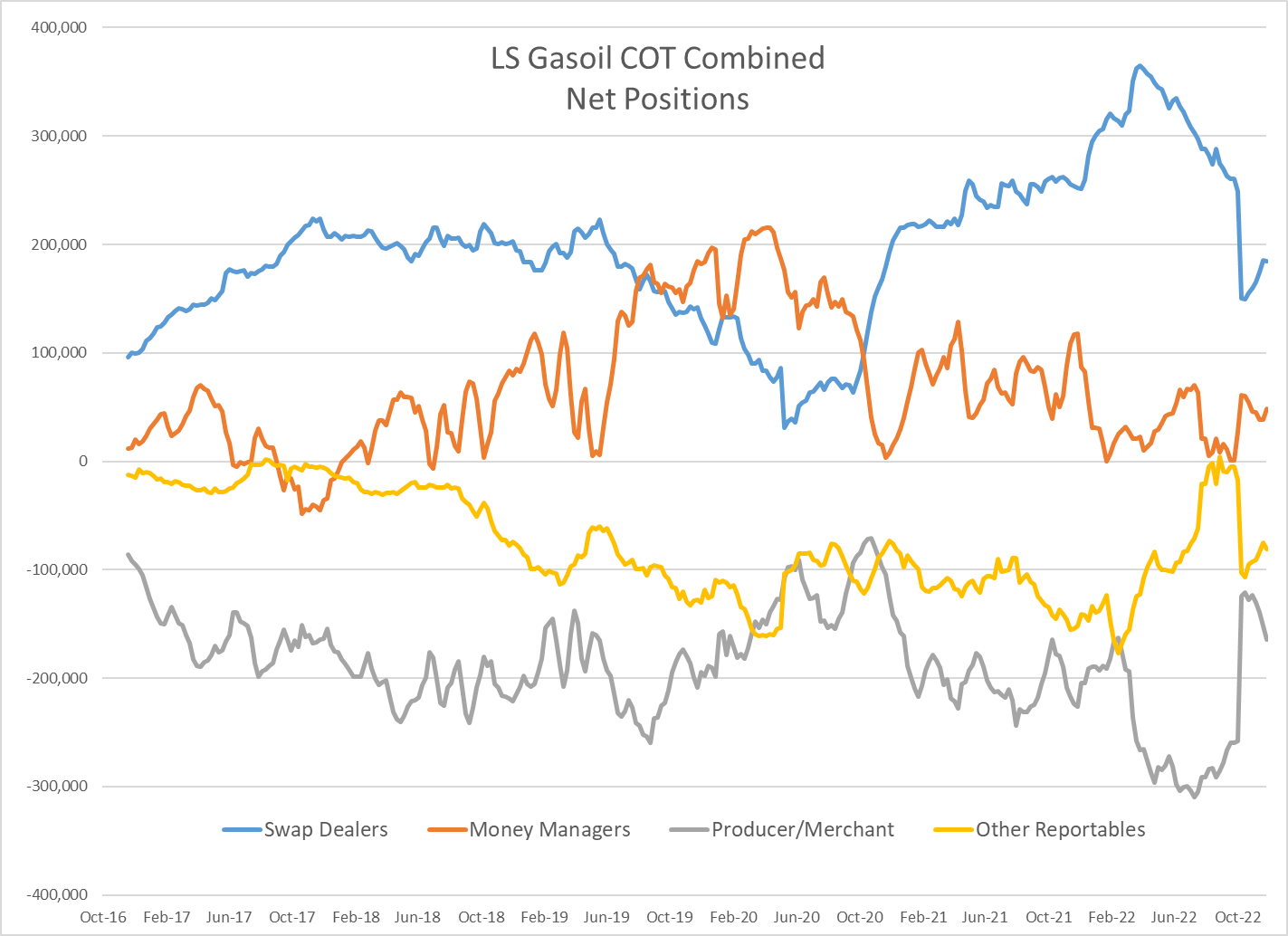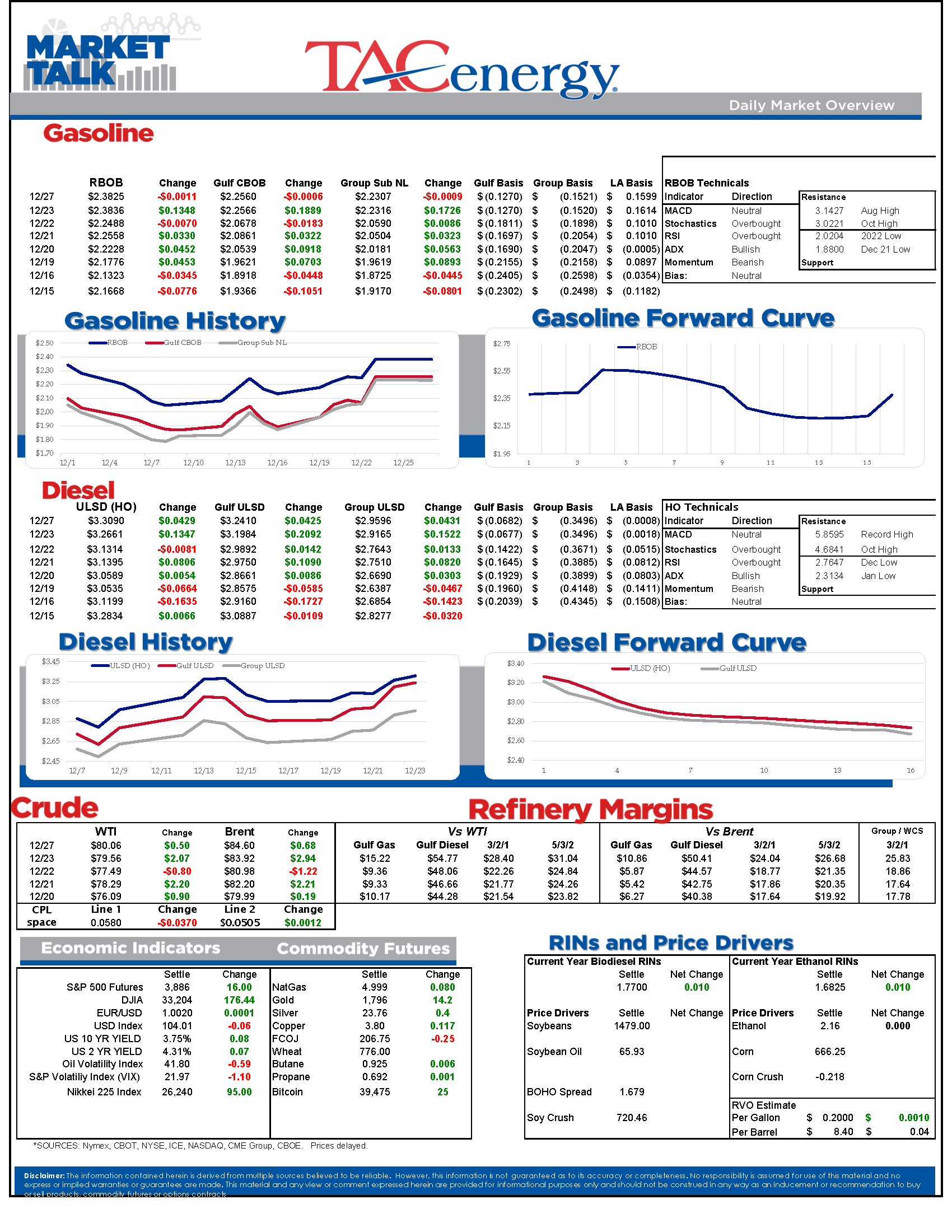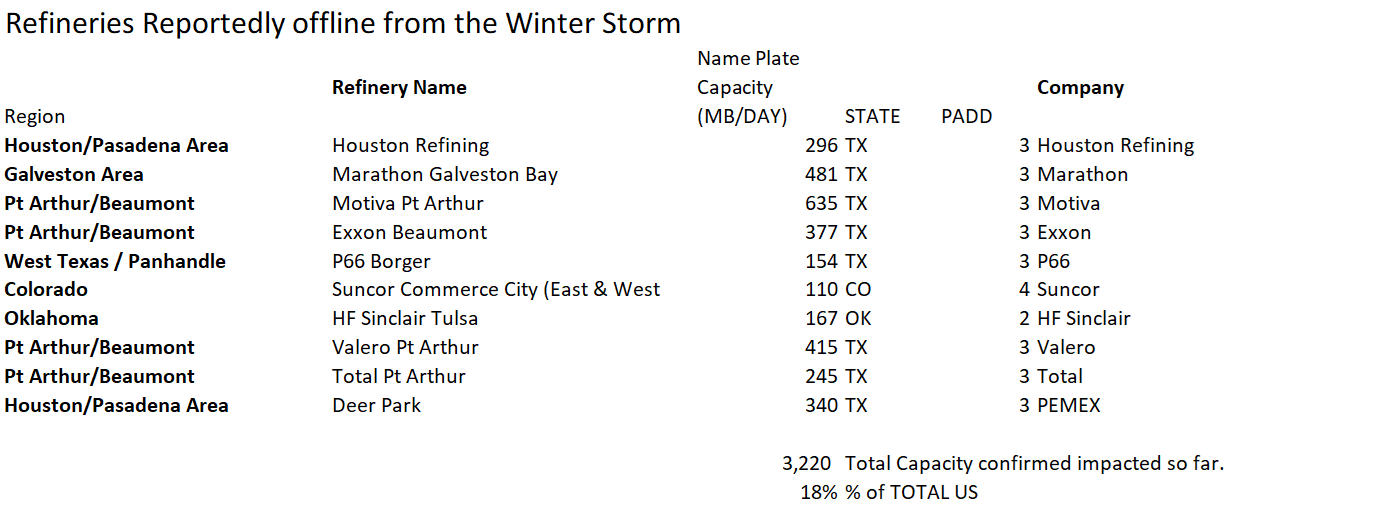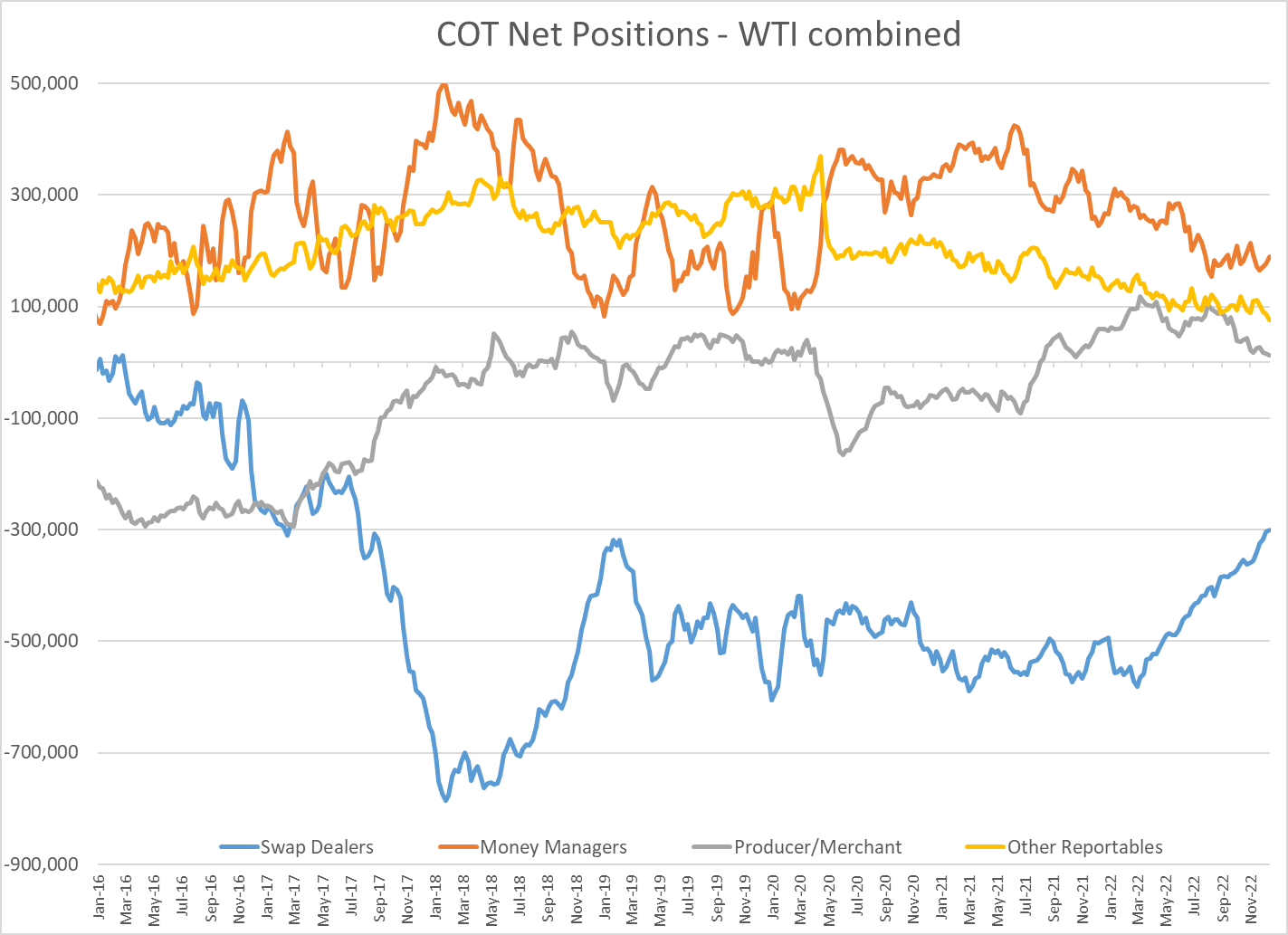Energy Futures Had A Big Rally On Friday

Energy futures had a big rally on Friday, and are following through with higher prices to start the short week as a pair of major supply disruptions, one actual and another potential, grip the market. ULSD continues to lead the move higher and came within striking distance of setting a new high for December overnight, marking a rally of more than 60 cents/gallon since bottoming out 2.5 weeks ago.
Russia threatened to cut its oil output in retaliation for sanctions on Friday, which sounds scary but may actually have to do more with limited options to sell and transport some of the nation’s production than a strategic plan to strike back at nations participating in the embargo.
Numerous refineries were knocked offline by the winter storm last week, including several of the largest in the country. Refineries accounting for approximately 18% of total US capacity had units reported offline over the weekend, although the total number of facilities impacted is likely to be much higher, which could place this event in the top 5 all time for disruptions. The steady stream of reports of refineries dropping had basis values for gasoline and distillates rallying in addition to the strong move higher in futures on Friday as the big physical shippers were scrambling to find replacement barrels.
Much warmer temps are sweeping the country allowing damage to be assessed and restarts to begin. While there’s never a good time for a mass refinery disruption, the week between Christmas and New Years typically has the weakest demand of the year, so may limit the impact of these shutdowns on the market. The timing is also likely to encourage some of those facilities to move up maintenance to take advantage of units already being offline and demand being weak. Oil and natural gas output was also hit by the huge storm, but it appears that the electric grids held up well in most cases, unlike what we experienced in early 2021.
The disruptions weren’t limited to production and refining facilities. Numerous terminals and pipelines across the country were reporting various issues, and vessel traffic in and around the NY Harbor was temporarily halted as the storm passed. Here too the impacts may have been much worse if they hadn’t happened just after the pre-holiday rush and just before Christmas day, which marks the slowest day for terminal loadings of the entire year.
Money managers were jumping back on the energy bandwagon last week with large percentage increases in net length seen across the board. While the percentage increases are large, the starting positions were fairly small, so the actual number of contracts added was less impressive. New length and short covering were consistent for crude and products, while open interest continues to hover near 6 year lows.
Baker Hughes reported 2 more oil rigs and 1 more natural gas rig drilling in the US last week, after both counts had declined in the prior 2 weeks. Drilling activity in the US has stagnated over the past couple of months as lower prices and various supply chain and labor shortages continue to have producers acting conservatively.
Keystone pipeline received approval to restart its shuttered line on Friday, with flows to the Cushing OK hub expected to resume this week.
Click here to download a PDF of today's TACenergy Market Talk.
News & Views
View All
The Recovery Rally In Energy Markets Continues For A 3rd Day
The recovery rally in energy markets continues for a 3rd day with refined product futures both up more than a dime off of the multi-month lows we saw Wednesday morning. The DJIA broke 40,000 for the first time ever Thursday, and while it pulled back yesterday, US equity futures are suggesting the market will open north of that mark this morning, adding to the sends of optimism in the market.
Despite the bounce in the back half of the week, the weekly charts for both RBOB and ULSD are still painting a bearish outlook with a lower high and lower low set this week unless the early rally this morning can pick up steam in the afternoon. It does seem like the cycle of liquidation from hedge funds has ended however, so it would appear to be less likely that we’ll see another test of technical support near term after this bounce.
Ukraine hit another Russian refinery with a drone strike overnight, sparking a fire at Rosneft’s 240mb/day Tuapse facility on the black sea. That plant was one of the first to be struck by Ukrainian drones back in January and had just completed repairs from that strike in April. The attack was just one part of the largest drone attack to date on Russian energy infrastructure overnight, with more than 100 drones targeting power plants, fuel terminals and two different ports on the Black Sea. I guess that means Ukraine continues to politely ignore the White House request to stop blowing up energy infrastructure in Russia.
Elsewhere in the world where lots of things are being blown up: Several reports of a drone attack in Israel’s largest refining complex (just under 200kbd) made the rounds Thursday, although it remains unclear how much of that is propaganda by the attackers and if any impact was made on production.
The LA market had 2 different refinery upsets Thursday. Marathon reported an upset at the Carson section of its Los Angeles refinery in the morning (the Carson facility was combined with the Wilmington refinery in 2019 and now reports as a single unit to the state, but separately to the AQMD) and Chevron noted a “planned” flaring event Thursday afternoon. Diesel basis values in the region jumped 6 cents during the day. Chicago diesel basis also staged a recovery rally after differentials dropped past a 30 cent discount to futures earlier in the week, pushing wholesale values briefly below $2.10/gallon.
So far there haven’t been any reports of refinery disruptions from the severe weather than swept across the Houston area Thursday. Valero did report a weather-related upset at its Mckee refinery in the TX panhandle, although it appears they avoided having to take any units offline due to that event.
The Panama Canal Authority announced it was increasing its daily ship transit level to 31 from 24 as water levels in the region have recovered following more than a year of restrictions. That’s still lower than the 39 ships/day rate at the peak in 2021, but far better than the low of 18 ships per day that choked transit last year.
Click here to download a PDF of today's TACenergy Market Talk.

Energy Prices Found A Temporary Floor After Hitting New Multi-Month Lows Wednesday
Energy prices found a temporary floor after hitting new multi-month lows Wednesday morning as a rally to record highs in US equity markets and a modestly bullish DOE report both seemed to encourage buyers to step back into the ring.
RBOB and ULSD futures both bounced more than 6 cents off of their morning lows, following a CPI report that eased inflation fears and boosted hopes for the stock market’s obsession of the FED cutting interest rates. Even though the correlation between energy prices and equities and currencies has been weak lately, the spillover effect on the bidding was clear from the timing of the moves Wednesday.
The DOE’s weekly report seemed to add to the optimism seen in equity markets as healthy increases in the government’s demand estimates kept product inventories from building despite increased refinery runs.
PADD 3 diesel stocks dropped after large increases in each of the past 3 weeks pushed inventories from the low end of their seasonal range to average levels. PADD 2 inventories remain well above average which helps explain the slump in mid-continent basis values over the past week. Diesel demand showed a nice recovery on the week and would actually be above the 5 year average if the 5% or so of US consumption that’s transitioned to RD was included in these figures.
Gasoline inventories are following typical seasonal patterns except on the West Coast where a surge in imports helped inventories recover for a 3rd straight week following April’s big basis rally.
Refiners for the most part are also following the seasonal script, ramping up output as we approach the peak driving demand season which unofficially kicks off in 10 days. PADD 2 refiners didn’t seem to be learning any lessons from last year’s basis collapse and rapidly increased run rates last week, which is another contributor to the weakness in midwestern cash markets. One difference this year for PADD 2 refiners is the new Transmountain pipeline system has eroded some of their buying advantage for Canadian crude grades, although those spreads so far haven’t shrunk as much as some had feared.
Meanwhile, wildfires are threatening Canada’s largest oil sands hub Ft. McMurray Alberta, and more than 6,000 people have been forced to evacuate the area. So far no production disruptions have been reported, but you may recall that fires in this region shut in more than 1 million barrels/day of production in 2016, which helped oil prices recover from their slump below $30/barrel.
California’s Air Resources Board announced it was indefinitely delaying its latest California Carbon Allowance (CCA) auction – in the middle of the auction - due to technical difficulties, with no word yet from the agency when bidders’ security payments will be returned, which is pretty much a nice microcosm for the entire Cap & Trade program those credits enable.










